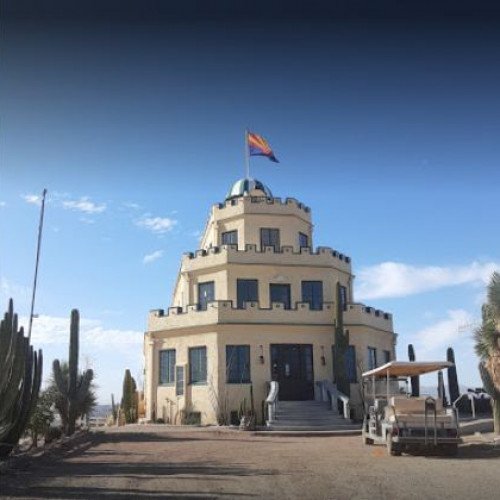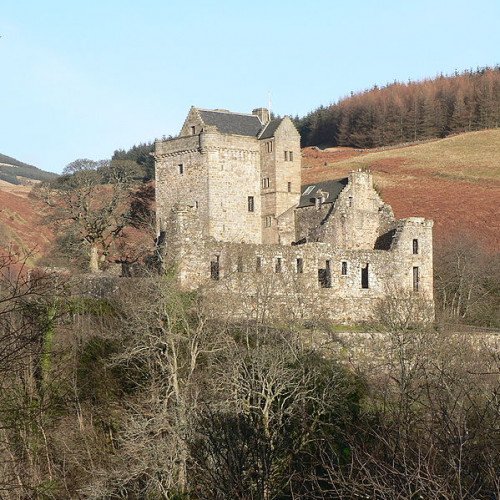Castles of "United States" CAMELBACK CASTLE vs CAMPBELL CASTLE

CAMELBACK CASTLE
The Copenhaver Castle is a true historical landmark property on Camelback Mountain. It is one of the most unique, well-known and recognized homes in the Phoenix area. To delve into its history is to learn the story of an eccentric Phoenix orthodontist whose vision for his own Spanish-style fortress in the heart of the desert led to an inspired architectural creation and a true historical landmark. In 1967 Dr. Mort Copenhaver purchased a just over 1 -acre, nearly vertical property at 5050 E. Red Rock Road on Camelback Mountain in Phoenix for the sum of $4000. At this time, it was believed by the sellers that the lot was unbuildable. The mountain was and remains home to some of the most scenic homes in all the Valley, but Copenhaver had a vision that would trump them all. Over the course of the next 12 years he set about creating his very own castle modeled after Moorish castle architecture and reminiscent of ancient castles found in Spain. From the very beginning it was clear that this was no ordinary structure. In fact its exterior walls are built of stone pulled from the mountainside itself, lending a natural aesthetic that rendered the castle quite literally a part of the mountain itself. It's priceless views of downtown Phoenix and incredible sunsets are unrivaled in their beauty. When Dr. Copenhaver was finished he had created a 7,807 square foot home with both modern features and historical flourishes inside. Nowhere else in the Valley, for example, could one find a home with a dungeon that just happens to include a wet bar. Or one that featured a draw bridge, or a 22-person Jacuzzi, and an adjacent sauna. The multi -level home featured 20 rooms in all, including five bedrooms, as well as 7.5 bathrooms, four fireplaces, four garages and carports, and even a 17 foot waterfall in the living room. In its heyday Dr. Copenhaver was quite the host, and lavish parties including A-list celebrities were a common theme. The uniqueness of the home brought much outside media interest, and it was featured on The Learning Channel and the BobVela show "This Old House" and in other media outlets. In addition, the home was opened up to tours for a fascinated public to raise money to perform dental work on the needy children of Phoenix. Dr. Copenhaver lost the home in bankruptcy proceedings in 1989, and while the home became a private residence after that, public fascination with this one-of-a-kind structure has remained steadfast. Now in the hands of a new owner with plans for an interior renovation and of re-opening the home to the public, The Copenhaver Castle promises to add new and exciting chapters to its storied history and remain a true crown jewel of the Arizona desert.
Statistics for this Xoptio

CAMPBELL CASTLE
Castle Campbell is a medieval castle situated above the town of Dollar, Clackmannanshire, in central Scotland. It was the lowland seat of the earls and dukes of Argyll, chiefs of Clan Campbell, from the 15th to the 19th century, and was visited by Mary, Queen of Scots, in the 16th century. Mary was impressed by this and said "this reminds me of home". The castle was originally known as Castle Gloom, possibly deriving from the Scottish Gaelic: glom, meaning a chasm, and referring to the narrow gorges to either side of the site. The naturally defended position may have been the site of a motte in the 12th century. The present tower was built in around 1430 for John Stewart, Lord Lorne (d.1463), or one of his kinsmen. About 1460, the property was acquired by Colin Campbell, 1st Earl of Argyll (d.1493), on his marriage to Isabel Stewart, Lord Lorne's daughter. The first historical record of the castle dates from the following year, when Pope Paul II issued a bull against Walter Stewart, son of Lord Lorne, for attacking and damaging the "Place of Glowm". Campbell, who was at the papal court at the time, may have been instrumental in arranging the Pope's intervention. The tower shows signs of early rebuilding following this episode. The acquisition of Castle Gloom expanded the power of the Campbell family, from Argyll in the west into central Scotland, and suited Colin Campbell's position as Master of the Household to King James III of Scotland, which required his frequent presence at court. In February 1490, Campbell petitioned the newly crowned King, James IV of Scotland, to formally change the name of Gloom to "Castle Campbell", and this was done by an act of parliament. The change in name may imply that the term "castle" was seen as particularly prestigious, requiring royal approval for its use. At this time, the castle would have comprised the tower house, with other buildings arranged around the courtyard and gardens outside. The east range was probably added first, and some time after the accession of the 2nd Earl in 1493, the large south range was begun. This building shows the influence of the contemporary works at Stirling Castle, now known as the King's Old Building. It included a state apartment of hall, outer chamber and bedchamber, with large south-facing windows overlooking the gardens, and a view across the Devon Valley. The range also provided additional private lodgings, and was accessed via two symmetrically placed stairways facing the courtyard.